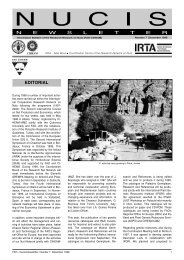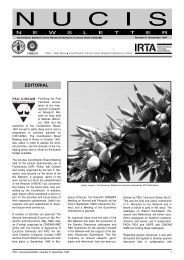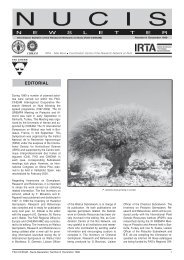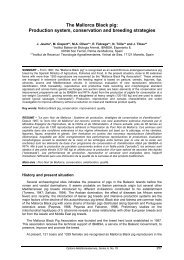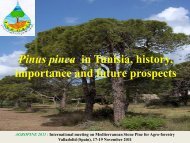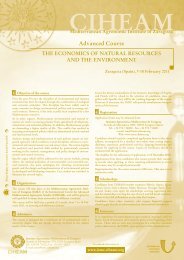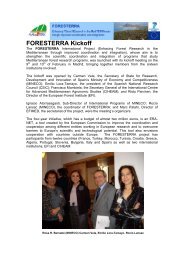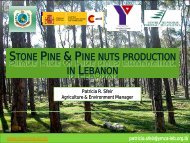NUCIS number 12. September 2004. 52 pages (full ... - IAMZ - ciheam
NUCIS number 12. September 2004. 52 pages (full ... - IAMZ - ciheam
NUCIS number 12. September 2004. 52 pages (full ... - IAMZ - ciheam
- No tags were found...
You also want an ePaper? Increase the reach of your titles
YUMPU automatically turns print PDFs into web optimized ePapers that Google loves.
and ‘Tomasa’, (Figures 4, 6, 12 and 14)are three excellent cultivars of Málaga,but they are harvested later than ‘Pilonga’and ‘Temprana’, at the end of October,when most of the Spanish chestnut productionis concentrated and prices areusually lower. Moreover, ‘Capilla’ and‘Tomasa’ showed the highest percentagesof split nuts and ‘Corriente’ the highestpercentage of poly-embryonic nuts. InHuelva four main cultivars should be promoted,‘Comisaria’, ‘Helechal’, ‘PlantaAlájar’ and ‘Vázquez’ (Figures 5, 8, 11and 15) due to their big nut size and lowpercentage of split nuts. ‘Planta Alájar’showed a higher percentage of poly-embryonicnuts. In comparison with cultivarsof Málaga, all cultivars in Huelva are harvestedat the end of October, main periodfor chestnut harvesting in Spain, whenprices are lower. Most of the cultivarsfrom Andalusia produce pollen, since onlyone accession studied of ‘Helechal’ wassterile. The most frequent type of malecatkin found was longuistaminate andonly ‘Planta Alájar’ and one accession of‘Dieguina’ showed mesostaminate catkins.‘Pelón’ (Figure 9) is a very spreadcultivar in Huelva that produces the smallestnuts in Andalusia what makes it lessinteresting for present market. These cultivarsare being collected and introducedin the Universidad de Santiago de Compostelato establish a core collection.REFERENCESCarballeira, A., 1983. Bioclimatologíade Galicia. Fundación Pedro Barrié dela Maza. ISBN: 84-85728-27.Pereira, S.; Fernandez, J. 1997. Loscultivares autóctonos de castaño (Castaneasativa Mill.) en Galicia. MonografíasI.N.I.A., 99: 1-533. ISBN: 84-7498-461-0Pereira, S.; B. Diaz, B.; Ciordia, M.; Ascasibar,J; Ramos, A.M.; Sau, F. 2001.Spanish chestnut cultivars. HortScience,36 (2): 344-347.Pereira, S.; Ramos, A.M. 2003. Característicasmorfológicas e isoenzimáticasde los cultivares de castaño (Castaneasativa Mill.) de Andalucía. Monografíasdel INIA, 13, 160 <strong>pages</strong>.Ramos, A.M.; Pereira, S. <strong>2004.</strong> Geneticrelationship between Castanea sativaMill. cultivars from North-western toSouth Spain based on morphologicaltraits and isoenzymes. Genetic Resourcesand Crop Evolution (in press).S. Pereira, A.M. RamosUniversidad de Santiago de Compostela,Escola Politécnica Superior, Departament ofProducción Vegetal, Campus de Lugo, 27002Lugo, SpainE-mail: spereira@lugo.usc.esTHE WORLD MACADAMIAINDUSTRY AND RESEARCHACTIVITIESINTRODUCTIONMacadamia is one of the world’s finestnuts. The kernel is consumed as salted orunsalted snack food, as chocolate enrobedconfectionary, and as an ingredientin products such as biscuits or ice-cream.The kernel has a high oil content (70-80%) and most of the oil is mono-unsaturatedlipids with 65.0 and 18.5% oleic andpalmitoleic acid respectively (Cavaletto etal., 1966). Oil content has been shown tobe an important component of quality;kernels with a specific gravity of 1.0 (oilcontent of more than 72%) or less wereidentified as having superior eating androasting qualities and are classed as firstgrade kernels or the commercial standard.Total sugar content of raw M. integrifoliakernel ranges from between 3 to5% (Riperton et al. 1938), the majority ofwhich is sucrose.The Macadamia genus is a member ofthe Proteaceace, which is a characteristicGondwana family (Johnson and Briggs,1983). Of the nine species, seven are endemicto Australia, with the other two occurringon the islands of Indonesia. Onlytwo of these species, M. integrifolia andM. tetraphylla produce edible kernel. Thesespecies occur as a medium sizedevergreen tree in the lowland subtropicalrainforests of eastern Australia. The fruitconsists of a fleshy husk (pericarp) surroundingthe hard shell (testa) and theedible kernel (embryo and cotyledons)(Gross 1995).WORLD PRODUCTIONMacadamias represent less than 2% ofthe world tree nut market. The market ischaracterised by undersupply and pricefluctuations (Hargreaves 2003).AustraliaAustralia is the main macadamia producerwith approximately 40% of the worldproduction or 10.000 t of kernel (Table 1).Despite recent surveys indicating thatabout 1/3 of the industry is new plantings,industry growth that was forecast at 15%yearly has not been reached (Hargreaves2003) due to poor seasons in 2002 and2003. The major growing regions arearound Alstonville (28 o 51’S, 153 o 21’E) inNorthern NSW and Bundaberg (24 o 33’ S,1<strong>52</strong> o 00’ E) in South Eastern Queenslandwith approximately 45 and 35 % of theAustralian crop produced in these areasrespectively. There is renewed interest toidentify new growing areas in Australia formacadamia production. The major marketsfor Australian production are USA,Japan, Germany and China.USAMacadamias were first commercialized inHawaii and most of the USA productioncontinues to originate from these islands.The Hawaiian industry is characterised bymature orchards with new plantings atmuch smaller levels than for the otherproducing countries (Vidgen 2003). Domesticsales, including duty-free, are amajor market of USA production. Exportsare shipped predominately to Japan.South AfricaOver 45% of the trees in South Africa areless than 5 years of age and there is thepotential for significant growth of this industry(Lee 2003). Production of kernelhas grown by about 30% between 2000and 2003 to approximately 3000 t despitepoor production seasons in 2002 and2003. Half its production is exported toUSA, with Europe being the next majormarket (25%).OthersMacadamias are also produced in Kenya(1500 t), Malawi (1000 t), Brazil (500 t),New Zealand (35 t), Thailand and CostaRica.HORTICULTUREPropagationMacadamias are generally clonally propagated.Seedling rootstocks are commonin Australia using open pollinated seedfrom the cultivar H2. Seedlings from othercultivars have also been used to a smallerextent. Practical experience suggeststhat the roots system is not well developedin cuttings of some varieties in Australia.There is little information to guideTable 1. Macadamia worldwide kernel production (t) (www.inc.treenuts.org)Region 2002 Import Production Domestic Export 2003Carry-overCarry-overAustralia 800 0 9.900 2.000 7.900 800Africa 43 0 6.440 190 6.250 30USA 2.000 7.466 5.500 <strong>12.</strong>216 770 2.000Latin America 170 0 3.370 300 3.070 170Total 3.013 7.466 25.210 14.706 17.990 3.00036 FAO-CIHEAM - Nucis-Newsletter, Number 12 <strong>September</strong> 2004



